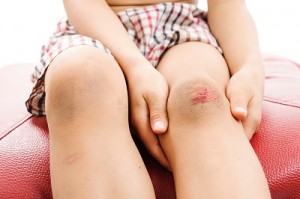How Can I Minimize Scars in My Child?
By Dr. Eddie Kubek, Carolinas Cleft & Craniofacial Institute
 Plastic surgeons spend years of training to learn how to minimize, camouflage, avoid or revise scars. This article passes on some of this knowledge, explaining what a scar is, answering common questions and sharing a few plastic surgery insights with parents.
Plastic surgeons spend years of training to learn how to minimize, camouflage, avoid or revise scars. This article passes on some of this knowledge, explaining what a scar is, answering common questions and sharing a few plastic surgery insights with parents.
Skin has three basic layers: the epidermis (the outer, visible layer), the dermis (the middle layer), and the hypodermis (the inner layer). Injuries to the epidermis only, such as a sunburn, will not leave a scar. But any injury involving the dermis, including surgical incisions, will heal with a scar.
The dermis is strong yet flexible. Your body repairs it by weaving a network of new elastic fibers to the healing edges of a wound, then pulls them together. However, the new fibers do not blend seamlessly with the original pattern. This is why a scar remains visible.
Although the new fibers will never completely match the old, there are a variety of ways to minimize scars, and several factors involved in optimal healing:
- Diet – As with all aspects of our lives, healing starts with a healthy diet. This means minimizing processed foods, high fructose corn syrup and artificial additives. It is important to maintain a healthy diet over time, because although healing may appear to take only a few weeks, the entire process lasts 12 months and beyond.
- Contamination – Dirt and grime in a new cut can lead to infection and poor wound healing. If your child suffers a deep cut, rinse it with a little soap and a lot of water, and remove any sand and grit. Some bleeding is okay and actually helps the healing process. If there is bleeding, hold pressure (about twice what it takes to make the skin under your fingernail turn white) with a towel for about 20 minutes. With bleeding slowed or stopped, apply a topical antibiotic like Neosporin. You should see a physician as soon as possible, but if you can’t, many cuts can be closed nicely even 24 hours later after the injury.
- Sun exposure – Please know that protecting a healing scar from the sun leads to a better color match when it is healed. Remember to use sunscreen. A minimum of SPF-30 is required, and should be applied even when wearing clothing, since the SPF of most materials is no more than eight to 10.
- Location – For any facial cuts on a child (with the exception of the scalp), it is normal to request a consultation with a plastic surgeon. You can save time, frustration and money by proceeding with item #2 above, then going directly to a children’s hospital or level 1 trauma center. This is because small hospitals and urgent care facilities are rarely staffed by plastic surgeons. When it comes to managing cuts, difficult areas of the body, even for plastic surgeons, include the chin, chest, neck, upper arm, lower eyelid and shoulders.
- Topical therapies – Creams, oils and silicone sheets are the most common topical therapies. Of these, clear silicone sheets worn over the scar for several weeks provide the most effective therapy. Inexpensive products like plain Vaseline® or sesame seed oil can soften scars, as can more expensive products like Mederma®.
- Massage – Probably the most reliable way to improve the appearance and texture of scar fibers is to firmly massage the scar using one of the oils or creams noted above. Beginning at about four weeks for new scars, and anytime for old scars, use your fingertips or thumb to firmly massage the scar vertically, horizontally and in circles several times per day. As with all other therapies, this must be done consistently for several weeks to soften or flatten a scar.
- Laser – Laser therapy is best for scars that remain red beyond 14 months. Please know that the treatments are expensive and are often not covered by insurance. Laser treatments require many repeat visits to the doctor, and unfortunately, results can vary widely.
Despite all efforts, scars sometimes remain quite bothersome. At this point you can consider a consultation with a plastic surgeon for revision. The strategies of surgical revision are to remove the scar and meticulously re-close the skin, re-orient the scar’s direction, camouflage the scar in natural shadows and creases, move it to a less visible location or replace a large area of scar using tissue expansion, or lastly, lengthen the scar (so it no longer pulls on the normal tissue) by changing its geometry.
Dr. Eddie Kubek is a plastic surgeon dedicated to pediatric and adult plastic surgery. He trained at Carolinas Medical Center and the University of Colorado. He is a partner with Dr. David C. Matthews. Their practice in Dilworth has served Charlotte area families for more than 25 years.
This blog was produced in partnership with Charlotte Parent. Click here for the original post and other parenting resources.













